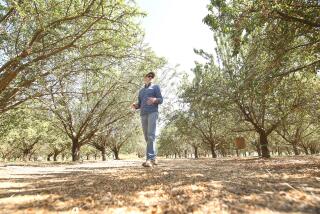THE BIZ : It’s a Bug-Eat-Bug World
- Share via
Jake Blehm, owner of Buena Biosystems in Santa Paula, is in the bug business. Not eliminating them--selling them. His insectary, like about 20 others in the state, raises killer bugs for farmers trying to cut back on pesticides. And business is booming.
For those of us with aphids on our roses and ants in our kitchens, raising insects might seem like an easy job. But it’s not: Keeping the little buggers fed is a major problem.
Among Blehm’s killers are green lacewings, “voracious pest consumers” that are most often used on aphids. In the larval stage, they are cannibalistic, so Blehm has to put five or six of them in separate compartments of a paper honeycomb and the winner (you know, survival of the fittest) will join a breeding colony, which can produce several million eggs a day.
When Glen Scriven, co-owner of Riverside-based Biotactics, sends out his bottles of 2,000 predatory mites, he makes sure there’s something for his little assassins to chew on (like their favorite food, spider mites, an agricultural pest) or Scriven’s nasty predators will just “eat each other.”
Reed Finfrock, owner of the Sespe Creek Insectary in Fillmore, has other problems. Like buying the 100 tons or so of banana squash for his Aphytis melinus , a wasp that eats California red scale off citrus plants.
Another problem for Finfrock is making people believe he’s delivered the goods. His wasps are so tiny that a customer can look into a coffee-cup-sized container of 50,000 of them and think he’s holding an empty cup. Finfrock gets tired of repeating, “I told you they were small!”
More to Read
Inside the business of entertainment
The Wide Shot brings you news, analysis and insights on everything from streaming wars to production — and what it all means for the future.
You may occasionally receive promotional content from the Los Angeles Times.










